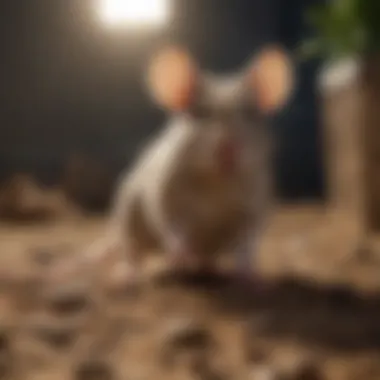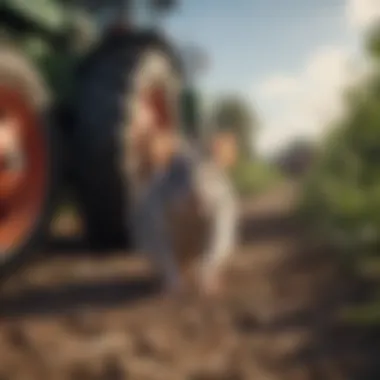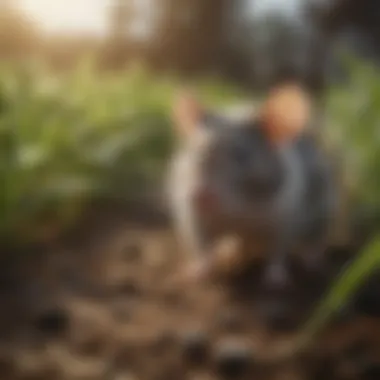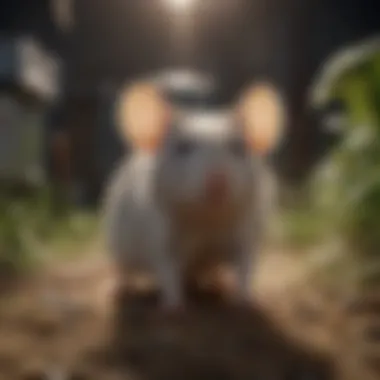Havoc Mice Killer: A Guide for Agricultural Use


Intro
In agricultural contexts, managing pest populations is crucial for optimizing crop yields and maintaining eco-balance. One product that has gained attention in this field is Havoc Mice Killer, a rodenticide specifically designed to address issues with rodents that can threaten agricultural productivity. This overview seeks to provide a deeper understanding of Havoc Mice Killer, elucidating its effectiveness, application methods, and the safeguards necessary for its responsible use in sustainable farming practices.
Key Concepts and Terminology
Basic Definitions
Understanding the core terminology associated with rodenticides is important. Rodenticide refers to any substance intended to kill rodents. Havoc Mice Killer falls under this classification. It targets mice and similar pests, ultimately aiming to protect crops from infestation. Knowing this allows farmers and agricultural enthusiasts to identify both when to use such products and how they work.
Historical Context
Historically, farmers have always battled against rodent infestations. The introduction of chemical rodenticides in the mid-20th century marked a significant development in pest management. Over time, products like Havoc Mice Killer have evolved, incorporating advances in chemical formulations and application technologies designed to boost efficacy while considering environmental impact. Regulations have shaped their use, reflecting changing perceptions of agricultural sustainability and safety.
Recent Innovations and Trends
Technological Advancements
Recent advancements in pest control have introduced more effective formulations and application techniques. Havoc Mice Killer uses cutting-edge technology that not only maximizes its impact on rodent populations but also reduces non-target risks. Furthermore, manufacturers continue to research and develop new delivery systems, such as bait stations, which provide controlled access to the pesticide, enhancing safety and usability.
Sustainable Practices
Sustainability is critical in modern agriculture. Utilizing Havoc Mice Killer aligns with integrated pest management (IPM), a holistic approach that combines biological, cultural, and chemical methods to manage pests. Applying Havoc responsibly allows farmers to balance pest control with environmental stewardship, thereby fostering sustainable farming practices. This integration is increasingly necessary as environmental regulations become stricter, necessitating responsible product usage that meets both agricultural and ecological objectives.
Practical Applications and Techniques
Step-by-step Guides
Using Havoc Mice Killer effectively requires adherence to specific steps:
- Assess the Infestation: Monitor areas for signs of rodent activity.
- Determine Application Method: Choose between bait stations or direct application based on the setting and risk factors.
- Follow Safety Protocols: Always wear gloves and a mask during application to minimize exposure.
- Place Baits Strategically: Position baits in high-activity areas while keeping them inaccessible to non-target species.
- Monitor the Efficacy: After application, check bait depletion levels and rodent activity to evaluate effectiveness.
Case Studies
Case studies illustrate the critical role of Havoc Mice Killer in actual farming situations. For instance, a corn farmer in Illinois reported a significant decrease in rodent activity following the implementation of targeted bait applications in conjunction with regular monitoring. The results not only improved his crop yields but also emphasized the importance of using rodenticides responsibly.
Preamble to Rodent Control in Agriculture
Rodent control is a critical aspect of agricultural management. The presence of rodents poses a significant threat to crops, livestock, and overall farm productivity. Effective rodent management not only protects the agricultural output but also ensures food safety and quality. As pest populations grow, they can lead to considerable economic losses. Therefore, understanding methods of control, including the use of specialized products like Havoc Mice Killer, is essential for every farmer and agricultural enthusiast.
The Importance of Pest Management
Pest management is crucial for a successful agricultural practice. Rodents are not just a nuisance; they are carriers of various diseases that can affect both animals and humans. Implementing comprehensive pest management strategies minimizes this risk and protects the food chain.
- Effective pest management helps in:
- Reducing crop damage.
- Preventing disease transmission.
- Lowering costs associated with pest control and crop loss.
- Enhancing overall farm productivity.
Farmers must recognize the seasonal patterns of rodent activity. Better understanding allows them to take proactive measures, ensuring timely intervention. Moreover, integrating different methods of control creates a robust strategy against rodents, creating a sustainable balance that fosters healthy farming practices.
Overview of Mice as Agricultural Pests
Mice are among the most prevalent pests in agricultural settings. They reproduce rapidly and can establish large populations quickly, making them a formidable challenge. Their behavior of gnawing on crops, stored grains, and equipment leads to extensive economic damage.


Some key characteristics of mice as pests include:
- High Reproductive Rate: A single pair of mice can produce dozens of offspring in a year, exacerbating infestation.
- Adaptability: Mice can thrive in various environments, from fields to barns, making them versatile pests.
- Destructive Feeding Habits: They not only consume crops but also cause damage to packaging and infrastructure.
The threat posed by mice cannot be overstated. If left unchecked, their presence can lead to severe agricultural losses. Understanding their behavior is thus essential for effective control.
Understanding Havoc Mice Killer
Havoc Mice Killer plays a significant role in pest management within agriculture. Understanding its composition and effective application is essential for optimizing its use. This section will provide a comprehensive view of Havoc Mice Killer, focusing on how it functions and its application forms.
Composition and Mechanism of Action
Havoc Mice Killer is a rodenticide formulated with specific active ingredients designed to control mouse populations. Primarily, it contains bromethalin, which is neurotoxic, affecting the central nervous system of rodents. Upon ingestion, bromethalin disrupts cellular respiration, leading to energy depletion in the brain. This results in paralysis and ultimately death in the targeted pests. It is crucial for users to understand how this compound operates to use it effectively and minimize potential risks to non-target species. In addition to bromethalin, the product may also contain attractants, which enhance its efficacy by drawing rodents to the bait.
- Active Ingredient: Bromethalin
- Mechanism: Disruption of cellular respiration
- Benefits: Quick action and effective rodent control
"Understanding the mechanism of action is vital for effective pest management and safer agricultural practices."
Forms of Application
Application methods for Havoc Mice Killer are fundamental in achieving optimal results. There are several forms to consider:
- Bait Stations: These offer a secure way to present the poison while preventing non-target animals from accessing it. They are an effective way to ensure the bait is consumed solely by rodents.
- Loose Bait: This method can be used in areas with high rodent activity but requires careful placement to avoid accidental ingestion by other animals.
- Pellet Form: Pellets can easily be scattered in infested areas, making them versatile in application.
When implementing Havoc Mice Killer, timing and placement are critical. The bait should be placed in locations where rodent activity is most evident, such as near droppings or burrow entrances. Regular inspection of bait stations is necessary to ensure that the bait remains attractive and potent.
Effectiveness of Havoc Mice Killer
The effectiveness of Havoc Mice Killer in agriculture is a critical aspect of pest management. Understanding how well this product works compared to other options is necessary for farmers looking to optimize crop production and minimize economic losses caused by rodent infestations. Effective rodent control not only protects yields but also supports overall ecological balance on farms.
Comparative Analysis with Other Rodenticides
Havoc Mice Killer distinguishes itself from other rodenticides in several ways. It is essential to assess its active ingredients, mode of action, and safety profile when evaluating its effectiveness. Many rodenticides contain anticoagulants, which require rodents to consume multiple doses over several days to achieve lethality. In contrast, Havoc uses a different approach that may result in quicker results, providing rapid control of mice populations.
- Speed of Action: The rapid action of Havoc may reduce the time rodents can damage crops.
- Resistance Management: Unlike some anticoagulant-based products, Havoc may be less likely to lead to resistance in rodent populations, making it a more sustainable option long-term.
- Environmental Impact: When comparing environmental safety, it is important to consider how Havoc interacts with non-target species. Some rodenticides create secondary poisoning risks. Studies indicate that Havoc's formulation has a lower likelihood of this, proving crucial in the context of integrated pest management strategies.
"Understanding the nuances between different rodenticides can inform better pest management strategies that protect both crops and the environment."
Case Studies in Agricultural Settings
Numerous case studies illustrate the efficacy of Havoc Mice Killer in varied agricultural settings. These practical examples provide insights into its successful application and the situations where it truly benefits farmers.
- Corn Production: In a corn-producing region, farmers reported a significant reduction in rodent activity when employing Havoc as part of their pest management practices. The transmission of mice in stored grains reduced, safeguarding the harvest.
- Vegetable Farming: A vegetable farm experienced an outbreak of mice in its fields. After implementing Havoc, the infestation diminished swiftly, leading to higher yields and better-quality produce.
- Orchard Management: An orchard manager documented the usage of Havoc over two seasons. Results showed a marked decrease in rodent numbers, allowing for healthier trees and improved fruit harvest.
These case studies underscore the practical benefits of using Havoc Mice Killer, further supporting its position in responsible agricultural practices.
Application Methods
The application methods of Havoc Mice Killer are crucial for its efficacy in controlling rodent populations in agricultural settings. Choosing the right method can significantly determine the success of rodent management strategies while minimizing risks to non-target species and the environment. Understanding the various application methods helps farmers optimize their pest control efforts.
Timing and Frequency of Application
Timing is a major factor that influences the effectiveness of Havoc Mice Killer. Applying it during specific seasons or periods when rodent activity peaks can enhance its impact.
- Early Planning: Implementing the product before planting can prevent rodents from becoming a problem as crops begin to establish. Preparations should also consider the life cycle of the rodents, as applying the bait at critical junctures can lead to higher efficacy.
- Regular Monitoring: Assessing rodent populations through traps can help inform when to administer Havoc Mice Killer again. Frequent applications may be required during harvest season, when food sources are reduced, thus pushing rodents to seek alternative sources.
- Environmental Conditions: Weather conditions play a role. Rain or moisture may wash away applications, while dry conditions may increase bait consumption. Therefore, adapting the timing based on environmental factors is key.


Target Areas for Treatment
Identifying target areas for treatment is vital for maximizing the effectiveness of Havoc Mice Killer. Focused applications minimize waste and ensure that the product reaches areas with high rodent activity.
- Field Borders and Perimeters: Rodents often traverse field edges. Strategic placement of bait stations at these locations can intercept rodents before they infiltrate main crop areas.
- Infestation Hotspots: Regular inspection of barns, storage facilities, and near irrigation systems can reveal hotspots where rodent activity is significant. Deploying Havoc Mice Killer in these sites requires careful attention to placement and bait levels.
- Storage and Waste Areas: Areas where organic waste accumulates attract rodents. Maintaining cleanliness is crucial, but placing bait stations where waste may be present can draw rodents away from crops.
It is essential to adhere to local regulations and best practices when applying rodenticides. Following these guidelines not only safeguards crops but also protects the surrounding ecosystem.
Using effective application methods ensures that Havoc Mice Killer can provide significant control over rodent populations, contributing to healthier crop yields and sustainable agricultural practices.
To summarize, understanding timing and frequency as well as target areas for Havoc Mice Killer applications is fundamental in ratifying pest management strategies designed for agricultural success.
Safety Precautions
Safety precautions play a crucial role when dealing with Havoc Mice Killer in agricultural settings. This topic highlights the necessity of adopting meticulous practices that protect not only the users but also the environment and non-target species. Implementing effective safety measures minimizes risks associated with rodenticide use, ensuring that pest management is both effective and responsible.
Handling and Storage Guidelines
Correct handling and storage of Havoc Mice Killer are fundamental to ensuring safety in agricultural operations. Here are essential guidelines for effective management:
- Store in Original Container: Always keep the product in its original, sealed container to prevent accidental ingestion or misuse.
- Cool, Dry Place: Store the rodenticide in a cool, dry area, away from direct sunlight and moisture to maintain its efficacy.
- Access Control: Ensure that access to the storage area is restricted to trained personnel only. This control is vital to prevent accidental exposure to unintended users, such as children or livestock.
- Label Reading: Always read the product label carefully before use. The label contains essential information on proper handling, storage, and emergency procedures.
- Proper Disposal: Follow local regulations for disposing of unused product and empty containers to avoid environmental contamination.
Protective Measures for Personnel
Personnel safety is paramount when working with Havoc Mice Killer. Several protective measures should be taken to minimize exposure and reduce health risks:
- Personal Protective Equipment (PPE): Always use appropriate PPE, such as gloves, masks, and goggles when handling the product. This equipment acts as a barrier against accidental exposure.
- Training and Education: Ensure that all personnel handling the rodenticide have received adequate training. Understanding the product's risks and safety procedures is essential.
- Emergency Procedures: Establish clear emergency procedures for accidental exposure, including eye flushing, skin washing, and immediate medical attention if needed.
- Spill Management: Have a spill kit readily available. In case of product spills, follow the correct procedures for containment and cleanup to avoid environmental hazards.
- Regular Health Checks: Conduct regular health assessments for all personnel who handle the product, checking for any signs of adverse effects or exposure complications.
Proper safety measures are not just regulatory obligations, but vital components of responsible agricultural practices. Adhering to these guidelines not only ensures compliance but also protects the health of workers and the integrity of the environment.
Environmental Considerations
Understanding the environmental considerations related to Havoc Mice Killer is crucial in agricultural settings. These factors ensure that while farmers effectively manage rodent populations, they do not compromise the surrounding ecosystem. The impact of rodenticides like Havoc extends beyond target species, potentially affecting various non-target organisms. Thus, integrating environmental considerations into pest management strategies is vital.
Impact on Non-target Species
The use of Havoc Mice Killer raises concerns about potential consequences on non-target species. Birds, mammals, and even insects can inadvertently come into contact with the pesticide. When these non-target creatures consume contaminated bait, it can lead to unintended mortality and ecological imbalance. Certain birds of prey, like owls and hawks, may suffer when they consume mice that have ingested the poison.
To mitigate these risks, farmers should consider adopting application methods that minimize exposure to non-target species. For instance, placing bait in inaccessible areas can help protect wildlife. Moreover, monitoring local wildlife populations can provide insights into any ecological shifts caused by rodenticide applications. Farmers must weigh the benefits of rodent control against the ecological implications of such actions.
Regulatory Compliance and Guidelines
Regulatory compliance governs the use of Havoc Mice Killer in agriculture. Various regulations exist to ensure that agricultural practices align with environmental safety standards. These laws help mitigate risks associated with pesticide application, ensuring that harmful effects on non-target species and human health are minimized.
Understanding local, state, and federal regulations is essential for farmers. They must be familiar with guidelines surrounding the proper use, application rates, storage, and disposal of Havoc Mice Killer. Compliance not only protects the environment but can also safeguard farmers from potential legal repercussions.
Adhering to best practices can enhance the effectiveness of Havoc while ensuring that the surrounding environment remains unaffected. Agricultural professionals should continually educate themselves on these regulations to maintain compliance and promote sustainable farming practices.
"Effective rodent management should always consider the broader ecological impact to preserve agricultural integrity."
Farmers play a pivotal role in implementing these guidelines. Proactive measures can greatly reduce the negative implications associated with rodenticides, allowing for a more balanced and safe agricultural environment.
Alternatives and Integrated Approaches
In the context of agricultural pest management, exploring alternatives and integrating diverse methods is crucial. This approach not only allows for effective rodent control but also emphasizes sustainable practices. Farmers and agricultural professionals are increasingly aware of the potential downsides of relying solely on chemical solutions like Havoc Mice Killer. Integrating alternative strategies helps to reduce the risks associated with rodenticides and promotes a more balanced ecosystem.


Biological Control Methods
Biological control methods involve the use of natural predators or pathogens to manage rodent populations. For example, the introduction of barn owls or other raptors can significantly reduce mouse numbers in fields and storage areas. These birds are efficient hunters and can keep the rodent population in check naturally.
Moreover, implementing habitat modifications can enhance the effectiveness of biological controls. By providing suitable nesting sites for these birds, farmers can create a more conducive environment for natural pest control. This approach not only reduces the need for chemical treatments but also supports local wildlife.
Some farmers have successfully utilized trap cameras to monitor rodent and predator activity. This data offers insights into which control methods are working best in their specific environments. Understanding the dynamics between prey and predator can ultimately lead to more informed decisions, helping farmers to adapt their approaches as necessary.
Cultural Practices for Rodent Prevention
Cultural practices encompass a range of strategies to prevent rodents from becoming a problem in the first pplace. These practices are often easy to implement and can be quite effective. Key cultural practices include:
- Crop Rotation: Changing the types of crops grown in specific areas can disrupt rodent habitats.
- Field Sanitation: Keeping fields clean of debris and weeds reduces hiding places for mice.
- Proper Storage: Safeguarding stored food and grain in secure containers helps to minimize access.
- Regular Monitoring: Routine inspections can help detect early signs of rodent activity, allowing for prompt action.
Integrating these cultural practices with biological controls and limited chemical uses offers a comprehensive approach to managing rodent populations. This strategy can lead to a significant reduction in pest numbers, while also promoting better environmental stewardship.
"Integrated approaches to pest management require understanding local ecosystems and adapting methods to suit specific conditions."
Ultimately, the focus should be on creating a long-term, sustainable pest management plan. By employing a mix of biological controls and cultural practices, farmers can engage in smart pest management that also preserves ecological balance.
Future Trends in Rodent Management
Understanding future trends in rodent management is crucial for effective agricultural practices. With evolving challenges in pest control, including changing rodent behavior and environmental regulations, it becomes necessary for farmers to stay informed. By capitalizing on emerging technologies and sustainable methods, agricultural professionals can enhance their approach to rodent management while ensuring minimal environmental impact.
Technological Innovations in Pest Control
The landscape of pest control is rapidly evolving, driven by technological advancements. Smart traps and sensors are just one aspect of this trend. These devices can monitor rodent activity and alert farmers when action is needed, allowing for a more targeted response.
Another innovation is the use of drones for surveying large areas, which can identify rodent infestations before they become significant problems. Drones provide a bird’s-eye view of crops and can be equipped with cameras to capture potential damage caused by mice.
Moreover, artificial intelligence and data analytics can be utilized to enhance decision-making by predicting rodent behavior and assessing risks. This level of foresight significantly improves efficacy in applying rodenticides like Havoc Mice Killer. The combination of these technologies establishes a proactive approach rather than a reactive one, ultimately leading to better management and reduced costs.
Sustainable Practices in Agricultural Pest Management
Sustainability is at the heart of modern agricultural practices. Moving away from solely chemical solutions, farmers are recognizing the importance of integrating sustainable methods into their pest management strategies. Biological controls, such as introducing natural predators of rodents, can help regulate populations without the need for extensive chemical use.
Crop rotation and the use of resistant crop varieties are additional methods that can decrease rodent activity. These practices disrupt rodent habitats and reduce the availability of food sources, which effectively lowers pest populations over time.
Furthermore, the incorporation of habitat management can create an environment less conducive to rodent habitation. By reducing clutter and maintaining clean storage areas for grains, farmers can significantly deter mice from infesting agricultural spaces. Taking these sustainable approaches aligns with broader environmental goals while enhancing agricultural productivity.
Embracing future trends in rodent management ensures that farmers can meet both pest control needs and environmental responsibilities.
The End
The conclusion in this article encapsulates the critical role of Havoc Mice Killer in the agricultural context. Effective rodent control is not just about eliminating unwanted pests; it touches on broader themes such as crop yield, economic viability, and environmental responsibility. By addressing both the immediate needs of pest management and the sustainable practices that govern modern agriculture, we aim to strike a balance that benefits farmers while protecting ecological integrity.
Summary of Key Insights
Havoc Mice Killer has several advantages when used correctly. First, it demonstrates notable efficacy against rodent populations which can devastate crops. This property plays an essential role in ensuring that farmers can meet production demands and maintain profitability. Second, we discussed various application methods and their alignment with safety protocols, clarifying how to minimize risks to non-target species and human health. These insights reinforce the necessity for meticulous planning and execution in rodent management.
Additionally, the discussion highlighted comparative analyses with other rodenticides, underscoring Havoc's performance in field studies. Understanding its advantages over alternatives allows farmers to make informed decisions tailored to their specific needs.
In sum, the key insights affirm that while Havoc Mice Killer is a powerful ally in agriculture, it demands responsible application to harness its full potential.
Recommendations for Sustainable Use
To ensure the sustainable use of Havoc Mice Killer, several best practices should be followed:
- Regular Training: Educate all personnel involved in pest management on safe application techniques and emergency protocols. This promotes safe handling and accountability.
- Integrated Pest Management (IPM): Combine Havoc Mice Killer with other pest control strategies. This reduces reliance on a single product, minimizing risks associated with potential resistance development among rodent populations.
- Monitoring and Evaluation: Implement a schedule for regularly assessing the effectiveness of rodent control measures. This enables quick adjustments based on observed outcomes in the field.
- Environmental Assessment: Before application, assess the surrounding environment for sensitive non-target species. Keeping track of local biodiversity helps in making safer choices that consider ecological balance.
These recommendations aim for a holistic approach, intertwining pest control efficacy with environmental stewardship. By incorporating such strategies, agricultural professionals can achieve effective rodent management while safeguarding the ecosystems on which they depend.















